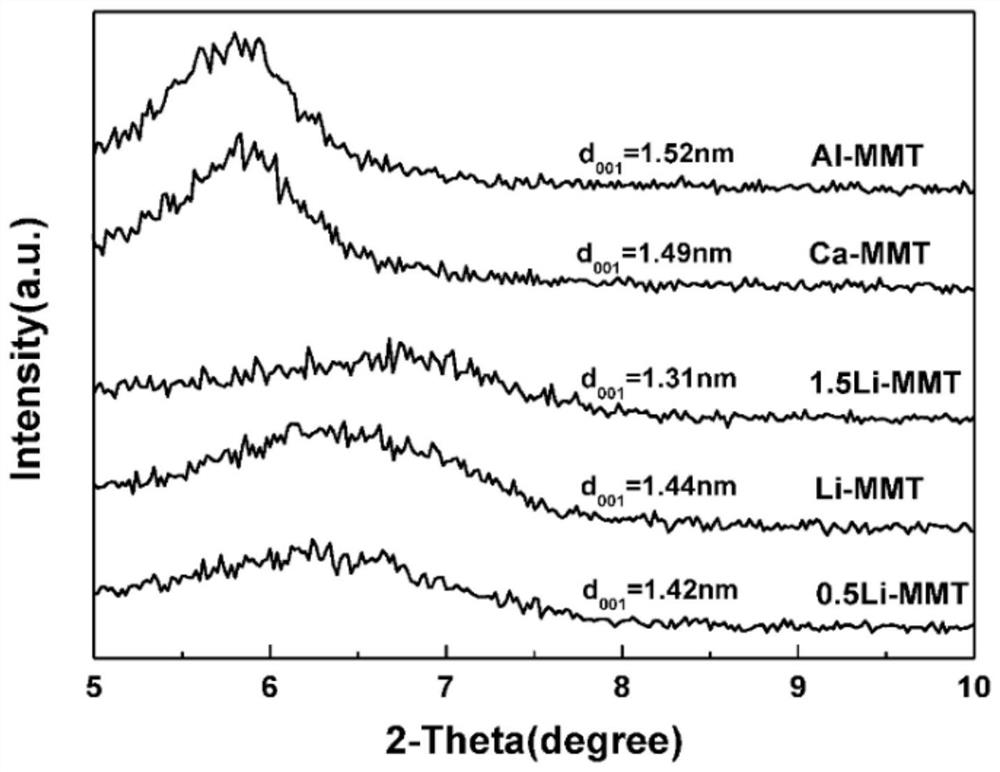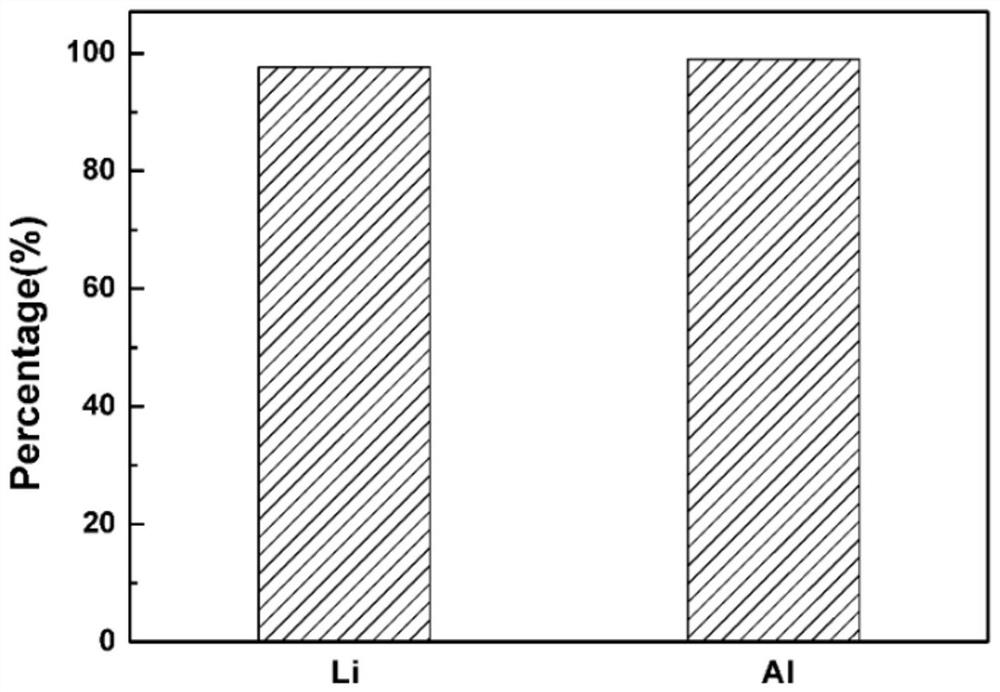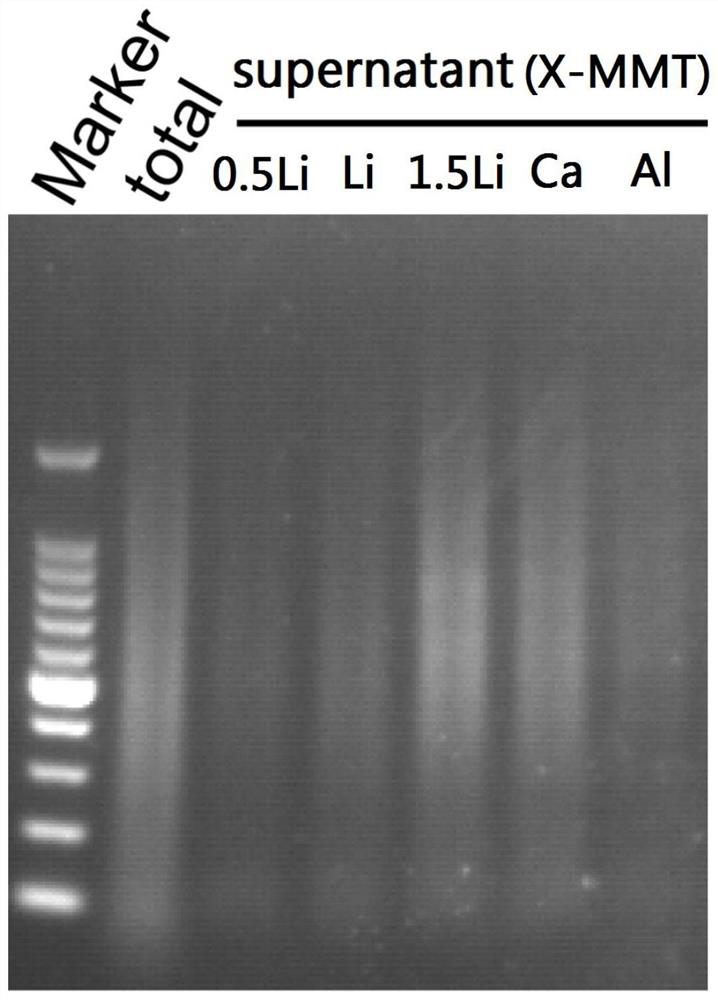Method for separation and purification of malignant tumor cell dna by cationic montmorillonite
A cationic, malignant tumor technology, applied in the field of separation and purification of malignant tumor cell DNA, can solve the problems of inconvenient high-throughput operation, single purification model, and high cost of material synthesis, so as to reduce the preparation cost, improve the dispersion effect, and enhance the adsorption. effect of action
- Summary
- Abstract
- Description
- Claims
- Application Information
AI Technical Summary
Problems solved by technology
Method used
Image
Examples
Embodiment 1
[0028] Culture HeLa cells in a 6cm-diameter petri dish, then add 500 μL of 2% sodium dodecyl sulfate solution to lyse, transfer the cell lysate into an EP tube and heat at 80°C for 5 min, at an amplitude of 20%, Sonicate at a power of 500W and store in a -20°C refrigerator for later use.
[0029] Preparation of lithium-ion montmorillonite:
[0030] Dissolve Li in 9 mL of deionized water 2 CO 3 0.23 g, add 1.00 g of calcium-based montmorillonite, react in a constant temperature water bath at 60 °C for 24 h, centrifuge, dry at 60 °C for 24 h, and store in a dry dish in an airtight manner, marked as 0.5Li-MMT.
[0031] DNA adsorption:
[0032] Take 70 μL of 30 g / L lithium-ion montmorillonite suspension, add 20 μL of cell lysate and 10 μL of sodium acetate solution with a pH of 5.0, react for 2 minutes and centrifuge at a centripetal acceleration of 5000 g for 2 minutes, take the supernatant and wash with agar The DNA content was determined by gel electro...
Embodiment 2
[0037] Culture HeLa cells in a petri dish with a diameter of 6 cm, then add 500 μL of 2% sodium dodecyl sulfate solution to lyse, transfer the cell lysate into an EP tube and heat at 90°C for 5 min, at an amplitude of 20%, Sonicate at a power of 500W and store in a -20°C refrigerator for later use.
[0038] Preparation of lithium-ion montmorillonite:
[0039] Dissolve Li in 9 mL of deionized water 2 CO 3 0.47 g, add 1.00 g of calcium-based montmorillonite, react in a constant temperature water bath at 60 °C for 24 h, centrifuge, dry at 60 °C for 24 h, and store in a dry dish in an airtight manner, marked as Li-MMT.
[0040] DNA adsorption:
[0041] Take 70 μL of 30 g / L lithium-ion montmorillonite suspension, add 20 μL of cell lysate and 10 μL of sodium acetate solution with a pH of 5.0, react for 2 minutes and centrifuge at a centripetal acceleration of 5000 g for 2 minutes, take the supernatant and wash with agar The DNA content was determined by gel...
Embodiment 3
[0046] Culture HeLa cells in a 6cm-diameter petri dish, then add 500 μL of 2% sodium dodecyl sulfate solution for lysis, transfer the cell lysate into an EP tube and heat at 100°C for 5 minutes, at an amplitude of 20%, Sonicate at a power of 500W and store in a -20°C refrigerator for later use.
[0047] Preparation of lithium-ion montmorillonite:
[0048] Dissolve Li in 9 mL of deionized water 2 CO 30.71 g, add 1.00 g of calcium-based montmorillonite, react in a constant temperature water bath at 60 °C for 24 h, centrifuge, dry at 60 °C for 24 h, and store in a dry dish in an airtight manner, marked as 1.5Li-MMT.
[0049] DNA adsorption:
[0050] Take 70 μL of 30 g / L lithium-ion montmorillonite suspension, add 20 μL of cell lysate and 10 μL of sodium acetate solution with a pH of 5.0, react for 2 minutes, and then centrifuge at a centripetal acceleration of 5000 g for 2 minutes. The supernatant was taken and the DNA content was determined by agarose g...
PUM
 Login to View More
Login to View More Abstract
Description
Claims
Application Information
 Login to View More
Login to View More - R&D
- Intellectual Property
- Life Sciences
- Materials
- Tech Scout
- Unparalleled Data Quality
- Higher Quality Content
- 60% Fewer Hallucinations
Browse by: Latest US Patents, China's latest patents, Technical Efficacy Thesaurus, Application Domain, Technology Topic, Popular Technical Reports.
© 2025 PatSnap. All rights reserved.Legal|Privacy policy|Modern Slavery Act Transparency Statement|Sitemap|About US| Contact US: help@patsnap.com



